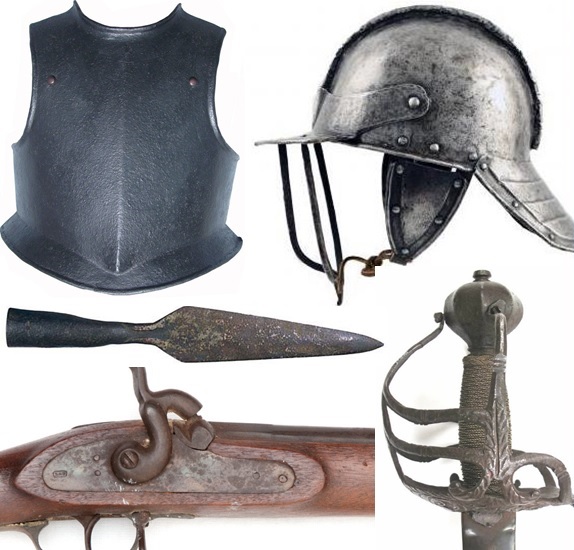
VISIT ANY COUNTRY house in England, and you are sure to find an armoury or furnishings with relics of the English Civil Wars. Over time many of these great armouries have been dispursed, and new relics have surfaced which means for the collector interested in this period there are a great range of civil war arms and armour to buy.
The English Civil War (1642-1651) was a series of conflicts between the King or ‘Cavaliers’ and Parliament, ‘the Roundheads’ in the middle of the 17th Century. The King, Charles I believed in the ‘Divine Right of Kings’ which asserts the monarch is given divine right to rule. He wanted to curb the powers of Parliament, whereas Parliament wanted more power. Both sides argued, chiefly about money and religion.
King Charles I, fed up with the arguments invoked a rule that allowed him to reign without recourse to Parliament, a period that became known as the ‘Eleven Year Tyranny’. During this period he found other ways of raising taxes, and tensions rose amongst the common people and Parliament. When Charles attempted to bring the Church of Scotland into line with the Church of England and Scottish soldiers invaded England, Charles called on Parliament to raise funds for war. Parliament used their position to negotiate concessions with the King and when negotiations broke down, the King raised an army to regain control. The English Civil war began.
The shortage of weapons on both sides meant that sustaining a long war would be difficult. Importing arms was expensive and often imports were poor quality. Private armouries were not enough to sustain armies. Both sides looked to home based arms manufacturing. Parliament, in control of the London arms industry had a strong manufacturing base that gave them a significant advantage. King Charles, with his control of areas where iron and coal was produced such as West Midlands and South wales, was able to muster local craftsman to equip his men almost as well.
Suprisingly due to the scale of the home based manufacturing operations there is a great deal of uniformity between arms. All miltary arms were supposed to conform to patterns held by the Tower of London. This meant that both sides largely used the same arms and armour. It also means for the collector there is a plentiful supply of civil war arms and armour available today; from muskets, cavalry and foot soldier equipment to ordnance.
Here are our top picks of English Civil War militaria and relics:
1) ‘Lobster pot’ helmet
A peculiar English design of helmet consisting of a dome in two halves with the joint forming a ridge, a neck guard similar in appearance to a lobster tail and a pivoted peak with a face guard made of three bars. The better quality helmets had a neck guard made of separate plates resulting in a flexible shield. Cheek pieces are generally one piece but on the best quality have some articulation. Expect to pay anywhere from £650 for a fair example.
2) Cavalryman ‘Harquebus’ Armour
By mid-seventeenth Century the armour of the cavalryman had reduced from something most would associate with a medieval knight to only back, breast and occasionally an elbow gauntlet to the left forearm and hand. Waistlines of armour are generally high to allow for comfortable sitting on horseback. Breast plates have a strong ridge and narrow flange. Back and front plates are held together by straps at the waist and shoulders. Original leather straps are rare as most have rotted. Frequently a circular dent appears, a proof mark made by a round fired from a musket. Values from the region of £1,250 upwards for a set of plates.
3) Flintlock and Matchlock Musket
Used by the infantry and dragoons there were two types of musket; the flintlock (lower priced issue) and the matchlock. Typically with a barrel around four feet long with a diameter that was 12 bore or big enough to load a lead ball weighing one twelfth or a pound. They were both loaded in the same way; gun powder was poured into the barrel and packed in hard with a stick. The lead ball would then be loaded in followed by wadding to hold the ball in place. Expect to pay in the region of £500 upwards.
4) Staff Weapon – The Pike
One of the most common weapons on the battlefield and often used to create the front line of the battle, the pike was a long shaft of ash with a steel point on the end, and balanced to make them easier to wield. Pikes were made to be sixteen feet long as a general rule but often soldiers shortened the shaft to make them easier to carry. Some carried steel strengthening towards the head to stop the tips being cut off with a sword blow. Expect to pay in the region of £50 upwards for an original pikehead.
5) ‘Mortuary’ Broadsword
Although firearms were important, the sword was the principal weapon of the Cavalry as well as for other soldiers. A number of different patterns and types exist for the roles. The ‘Mortuary Sword’ was a English broad sword and one of the most iconic weapons of the period. The design features a hilt of iron, a dish shaped guard with wide wrist protection, one central knuckle guard and two side knuckle guards. Often swords carried unique decoration such as armed figures or coats of arms. Expect to pay in region of £750 upwards.
As with all of our picks, prices are a guide only and may vary. As with any militaria purchase, it is ‘caveat emptor’, buyer beware. Do your research, know what you are looking at through research and ask the right questions of the buyer. So now you know our thoughts on what English Civil War Relics may be worth picking, where do you go next. Our Buy pages of course >>

